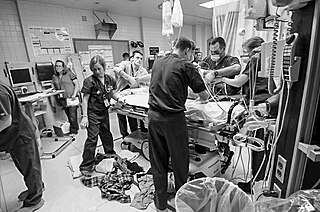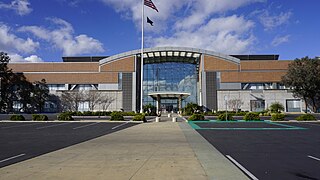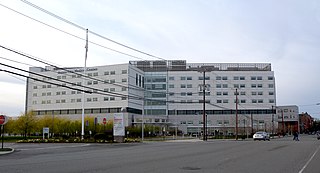Related Research Articles

In medicine, triage is a process by which care providers such as medical professionals and those with first aid knowledge determine the order of priority for providing treatment to injured individuals and/or inform the rationing of limited supplies so that they go to those who can most benefit from it. Triage is usually relied upon when there are more injured individuals than available care providers, or when there are more injured individuals than supplies to treat them.

The Emergency Medical Treatment and Active Labor Act (EMTALA) is an act of the United States Congress, passed in 1986 as part of the Consolidated Omnibus Budget Reconciliation Act (COBRA). It requires hospital emergency departments that accept payments from Medicare to provide an appropriate medical screening examination (MSE) for anyone seeking treatment for a medical condition regardless of citizenship, legal status, or ability to pay. Participating hospitals may not transfer or discharge patients needing emergency treatment except with the informed consent or stabilization of the patient or when the patient's condition requires transfer to a hospital better equipped to administer the treatment.

Emergency medicine is the medical speciality concerned with the care of illnesses or injuries requiring immediate medical attention. Emergency physicians specialize in providing care for unscheduled and undifferentiated patients of all ages. As first-line providers, in coordination with emergency medical services, they are primarily responsible for initiating resuscitation and stabilization and performing the initial investigations and interventions necessary to diagnose and treat illnesses or injuries in the acute phase. Emergency medical physicians generally practice in hospital emergency departments, pre-hospital settings via emergency medical services, and intensive care units. Still, they may also work in primary care settings such as urgent care clinics.

An emergency department (ED), also known as an accident and emergency department (A&E), emergency room (ER), emergency ward (EW) or casualty department, is a medical treatment facility specializing in emergency medicine, the acute care of patients who present without prior appointment; either by their own means or by that of an ambulance. The emergency department is usually found in a hospital or other primary care center.
A trauma center, or trauma centre, is a hospital equipped and staffed to provide care for patients suffering from major traumatic injuries such as falls, motor vehicle collisions, or gunshot wounds. A trauma center may also refer to an emergency department without the presence of specialized services to care for victims of major trauma.

Ambulatory care or outpatient care is medical care provided on an outpatient basis, including diagnosis, observation, consultation, treatment, intervention, and rehabilitation services. This care can include advanced medical technology and procedures even when provided outside of hospitals.

Westmead Hospital is a major teaching hospital in Sydney, Australia. Opened on 10 November 1978, the 975-bed hospital forms part of the Western Sydney Local Health District, and is a teaching hospital of Sydney Medical School at the University of Sydney.

Blacktown Hospital is a university teaching hospital in Blacktown, New South Wales, Australia, about 34 kilometres from the Sydney CBD. Together with Mount Druitt Hospital and associated community health centres, it is a part of the Western Sydney Local Health District (WSLHD). The hospital is located in one of the fastest population growth areas in NSW, caring for patients from highly diverse cultural and social-economic status backgrounds.

The Royal North Shore Hospital (RNSH) is a major public teaching hospital in Sydney, Australia, located in the suburb of St Leonards. It serves as a teaching hospital for Sydney Medical School at the University of Sydney, University of Technology Sydney and Australian Catholic University and has over 600 beds.
Emergency psychiatry is the clinical application of psychiatry in emergency settings. Conditions requiring psychiatric interventions may include attempted suicide, substance abuse, depression, psychosis, violence or other rapid changes in behavior.

An intensive care unit (ICU), also known as an intensive therapy unit or intensive treatment unit (ITU) or critical care unit (CCU), is a special department of a hospital or health care facility that provides intensive care medicine.

Mona Vale Hospital is located in the suburb of Mona Vale, on the Northern Beaches of metropolitan Sydney, Australia. It is a public hospital managed by New South Wales Health, and part of the Northern Sydney Local Health District.

The Jersey City Medical Center is a hospital in Jersey City, New Jersey. The hospital has had different facilities in the city. It is currently located on a 15-acre campus at Grand Street and Jersey Avenue overlooking New York Harbor and Liberty State Park. The campus includes three facilities: the Wilzig Hospital, the Provident Bank Ambulatory Center, and the Cristie Kerr Women's Health Center. The hospital serves as a regional referral and teaching hospital.

Patient dumping or homeless dumping is the practice of hospitals and emergency services inappropriately releasing homeless or indigent patients to public hospitals or on the streets instead of placing them with a homeless shelter or retaining them, especially when they may require expensive medical care with minimal government reimbursement from Medicaid or Medicare. The term homeless dumping has been used since the late 19th century and resurfaced throughout the 20th century alongside legislation and policy changes aimed at addressing the issue. Studies of the issue have indicated mixed results from the United States' policy interventions and have proposed varying ideas to remedy the problem.

Middlemore Hospital is a major public hospital in the suburb of Ōtāhuhu, Auckland, New Zealand. The hospital has approximately 800 beds. There are 24 operating theatres across two sites.
Spartanburg Regional Healthcare System(SRHS) is one of South Carolina's largest healthcare systems. SRHS draws patients primarily from the areas of Spartanburg, Cherokee, Union, and Greenville counties (all located in the Piedmont region of South Carolina), as well as Rutherford and Polk counties (located in western North Carolina). Spartanburg General Hospital was organized under the authority of the South Carolina General Assembly in 1917. It officially became the Spartanburg Regional Health Services District, Inc., a political subdivision of the State of South Carolina, by the charter granted by the Secretary of State of South Carolina on May 1, 1995.
The Emergency Medical Services for Children (EMSC) program is a US federal government health initiative. It is administered by the U.S. Department of Health and Human Services’ Health Resources and Services Administration (HRSA), and the Maternal and Child Health Bureau (MCHB). Its aim is to reduce child and youth disability and death due to severe illness or injury by increasing awareness among health professionals, provider and planners and the general public of the special needs of children receiving emergency medical care.
The Garling Report is a 2008 report prepared by the office of the Australian Commissioner Peter Garling, SC following a series of high-profile medical mishaps in the New South Wales public hospital system. For the duration of the commission, it was well covered by mass media. Its final 139 recommendations stimulated considerable discussion and controversy.
Belmont Hospital is an acute care public hospital servicing the City of Lake Macquarie in New South Wales, Australia. Established in 1968, it is the only public hospital in the Local Government Area and is located on Croudace Bay Road in the suburb of Belmont. The hospital is operated by the Hunter New England Local Health District. The hospital underwent a major $31.5 million redevelopment between 2003 and 2007 allowing it to expand the range of specialist services available.
The Bureau of Health Information (BHI) is a board-governed organisation that publishes independent reports about the performance of the public healthcare system in New South Wales, Australia.
References
- ↑ "News You Can Use: Health Care Glossary". ABC News . October 13, 2006. Retrieved June 26, 2011.
- 1 2 Alberta Health Services. Acute care. Accessed 3 August 2011.
- ↑ Canadian Institute for Health Information. Acute care. Archived 2011-09-29 at the Wayback Machine Accessed 3 August 2011.
- ↑ Garling, Peter. Final Report of the Special Commission of Inquiry into Acute Care Services in NSW Public Hospitals, November 2008. Accessed 3 August 2011.
- ↑ "EMTALA.COM - Resources and information". www.emtala.com.